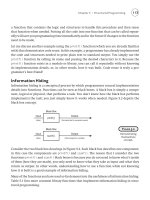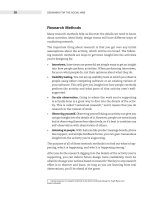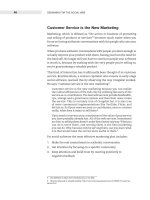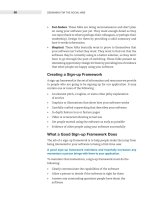designing for the social webj PHẦN 8 potx
Bạn đang xem bản rút gọn của tài liệu. Xem và tải ngay bản đầy đủ của tài liệu tại đây (7.74 MB, 20 trang )
ptg
128 DESIGNING FOR THE SOCIAL WEB
Complex Systems Everywhere!
Digg is merely one of many sites that are complex adaptive systems.
Consider popular web destinations that similarly aggregate behavior.
.
Amazon aggregates the collective opinion of the people reading
product reviews to determine which reviews are helpful.
. Google aggregates the collective opinion of people who create and
link to web pages, assessing where to display pages in results.
. Netflix aggregates the collective ratings of millions of movie fans
to provide better movie recommendations.
.
Wikipedia aggregates the collective knowledge of its editors to
provide a single, authoritative encyclopedia.
. eBay aggregates the collective feedback of buyers to provide seller
ratings that influence whether a deal goes through or not.
Collective Intelligence
The goal of many of these complex systems is the same: to aggregate
the individual actions of many people in order to surface the best or
most relevant content. The intelligence that emerges from this activity
is often called collective intelligence.
5
Collective intelligence is based on the idea that by aggregating the
behavior of many people, we can gain novel insights.
How Complex Adaptive Systems Work
Digg and other aggregation systems rely on the fact that while no indi-
vidual is right all the time, in the collective a large number of users can
be amazingly accurate in their decisions and choices. Amazon, Digg,
Google, Netflix, and many other sites base their recommendations of
products, news, sites, movies, etc., on aggregated opinion.
To do this, the sites record the actions of all the people using the system
and look for patterns in that behavior. Where patterns emerge, intel-
ligence arises. In general, this can be described as a three-step process:
. Initial Action. Content is submitted into the system. On Digg, this
happens when someone submits a story. On Amazon, it happens
when someone writes a product review. From here, the life of the
content is outside of the submitter’s hands, as its fate is determined
by the rules of the system and its interaction with other people.
5 />ptg
CHAPTER 6 DESIGN FOR COLLECTIVE INTELLIGENCE 129
. Display. The content is displayed for others to see and act on. How
each site displays content depends on the goals of the site, including
time of submission, rate of other submissions, as well as various
algorithms that predetermine relevancy. The display changes over
time as more content is introduced, which is one of the hallmarks
of adaptive systems.
. Feedback. The people using the system are given an opportunity to
provide feedback on the content to assess its quality. They can pro-
vide positive feedback to signal good content, or negative feedback
to signal bad content. The system then adjusts and redisplays the
content, starting a feedback loop. This feedback loop continues and
the content can either rise to the top, stabilize in some way, lose its
novelty and drop off, or get removed if deemed inappropriate.
The following table illustrates different forms of the three steps for
many popular social systems.
Action Display Feedback
Digg Submitting a news story Upcoming, popular, homepage Digg, share, and bury stories
Amazon Writing a product review Mostful, most recent Is this Helpful?
Report this, Comment
Netfl ix Rating a movie Recommended movies Add to queue, Rate movie,
Not interested
Google Writing a web page Results based on Link between web pages,
relevancy Click on search results
Wikipedia Starting an article Article page Edit articles over time
Del.icio.us Saving & tagging a Most popular, Related tags, Copy bookmarks
bookmark all tags
Flickr Uploading and tagging Interestingness, popularity, Taggi n g , setti n g Favor i te s
a picture clusters
YouTu be Uploading a video YouTu be int e r fa ce , Favorite it, Report it,
embedded in blogs Embed it
Initial Action
The first step in an adaptive system occurs when people add content to it.
Adaptive social systems need a constant supply of fresh content to
maintain the interest of their users. However, the rate of flow of new
content must be regulated carefully, or else too much content vies for
people’s limited attention.
ptg
130 DESIGNING FOR THE SOCIAL WEB
We are all too familiar with the pain of wading through a basically
unrestricted flow of content. The email system, which makes sending
content effortless and essentially free, is nearly overwhelmed with
SPAM. Systems need a way to control the influx of content.
Barriers to Entry
A hurdle that prevents participation is called a barrier to entry. Barriers
to entry are commonly described as beneficial in the business world, as
they keep competitors from entering a market. In the social software
world, the removal or creation of barriers to entry is crucial to the overall
health of the system.
Derek Powazek, who wrote the book Design for Community,
6
notes that
“all communities are exclusionary to some degree.” He distinguishes
between three types of barriers to entry:
. Informal barriers. Informal barriers are those that exclude subtly,
such as design with an aesthetic that attracts a certain type of
person, or copywriting that speaks to a specific audience.
.
Formal barriers. Formal barriers to entry are things that exclude
blatantly, like requiring an account, requiring certain software, or
any planned measure that restricts participation.
. Extreme barriers. Extreme barriers are those that create exclusiv-
ity by only allowing certain people in. The invitation-only social
network asmallworld.com, which caters to the rich and famous, is
a good example of an extreme barrier to entry.
On Digg, like on many social sites, you need an account to submit stories.
Then, the process of submitting stories has two steps.
The first step is to enter the link you’re submitting. This is a normal URL.
You also choose the t ype of content it is: a news story, image, or v ideo.
Digg helps people by providing a nice set of guidelines.
After you click “Continue” in step 1, Digg takes a moment to analyze the
link to see if it’s a duplicate. This helps keep the system clean. When
Digg thinks you’ve submitted duplicate content, it notifies you that the
story has already been submitted.
6 Powazek, Derek, Design for Community. New Riders, 2006.
ptg
CHAPTER 6 DESIGN FOR COLLECTIVE INTELLIGENCE 131
Figure 6.2 The fi rst step in submitting content to digg.com. The helpful submission
guidelines head off problems before they occur.
Figure 6.3 Digg checks to makes sure that your submission isn’t a duplicate. This keeps
redundant content out of the system.
If the submission is not a duplicate, Digg analyzes the page and grabs
any relevant content from it, including the page title, a description, and
any images in the page. It then allows you to choose which elements are
appropriate as part of your submission. This step makes it much easier
to digg content, as you don’t have to do any heavy lifting of grabbing
the content yourself.
Finally, Digg adds a check to make sure that the submitter of content
is indeed a human being.
The initial action on Digg is a crucial step in the system. It determines
what content is allowed, makes sure the content is unique, adds data that
supports the story, and determines who can and cannot submit content.
These decisions act as a barrier to entry to the rest of the system. The
quality of content that receives entry into the Digg system depends on
the checks at this stage.
ptg
132 DESIGNING FOR THE SOCIAL WEB
Figure 6.4 Step 2 of the Digg submission process makes it easy to customize a
submission yet verifi es that the submitter is a person.
ptg
CHAPTER 6 DESIGN FOR COLLECTIVE INTELLIGENCE 133
Other Examples of Initial Action
Adaptive systems do checks on the initial action in many different
ways:
.
Techmeme is a news site that aggregates the current news from
blogs and other news sources. It started by sourcing its content from
a small, core set of blogs, prioritizing their content over the content
of others. At present, it sources its content from a larger corpus of
sources, but still allows for the serendipity of unknown blogs to
appear in its pages.
.
Yahoo Buzz also aggregates news, but uses a group of select publish-
ers as content providers, keeping the number of sources who can add
content relatively low. By using only trusted sources, Yahoo keeps
quality high, but doesn’t have the serendipity of Techmeme.
. Google Search indexes everything on the web, which makes their
initial sample of content extremely large, before they determine the
value of that content by studying the interconnectedness among
the pages.
. Amazon moderates customer reviews to make sure that they are
relevant and on-topic, weeding out overly promotional and machine-
generated reviews. This keeps the content in the system relevant.
Adding Tags
Some services allow people to tag content, which allows aggregation of
the content in additional, helpful ways. For example, the social book-
marking site Del.icio.us lets you add tags to bookmarks as you enter
them into the system.
Figure 6.5 Del.icio.us allows people to tag bookmarks as they enter them into the
system. This allows the site to aggregate and display tags in helpful ways.
ptg
134 DESIGNING FOR THE SOCIAL WEB
Preprocessing Content Before Display
All content in a system is not equal. Some content may come from
authoritative sources, while other content might come from suspect
sources. For example, since Google indexes the entire web, it is important
for them to analyze where the content comes from to try to determine
what is relevant and what is not. Otherwise, sites built by spammers
could potentially have as much authority as honest sites.
Not all sites do preprocessing like this. Digg and Amazon simply accept
all new content as equal. It doesn’t matter who wrote the review on
Amazon, or who submitted a story on Digg, it will be added just the
same way as usual.
Aggregate Display
The display of content is crucial to how people interact with it. If content
is displayed prominently then people will consider it more important.
Content displayed less prominently will be considered less important.
In general, content is deemed more important when it is displayed:
. On a home page. The home page is visited the most of any page,
and therefore it garners the most attention from both site owners
and readers.
. More often. The more content is displayed and repeated, the more
it is considered valuable.
. At the top of a page. Just like on the front of a newspaper, above the
fold is the prime real estate. The top of a web page is where the most
important content is placed online.
. Higher in ranked displays. When content is ranked, such as in a “most
emailed” list, the content at the top is deemed most valuable.
When content first gets added to an adaptive system, it is usually dis-
played in an appropriately less prominent location. Digg, for example,
has what they call an Upcoming page, which displays all new submis-
sions into the system in reverse-chronological order. These freshly-
submitted stories stay on the upcoming page a short period of time,
getting pushed off in favor of even fresher content. The Upcoming page
is crucial to the functioning of the Digg site because it forces each story
to gain its own popularity.
ptg
CHAPTER 6 DESIGN FOR COLLECTIVE INTELLIGENCE 135
Figure 6.6 Digg’s Upcoming page shows freshly-submitted stories.
All of these stories aspire to reach the Digg home page, the ultimate place
for grabbing attention, where they will be seen by thousands of people
in a very short period of time. In fact, the burst of attention resulting
from being on the Digg homepage often makes sites unreachable. So
many people visit the site from Digg that the web server is overwhelmed
and either slows to a crawl or breaks outright.
Figure 6.7 The venerable Digg homepage.
ptg
136 DESIGNING FOR THE SOCIAL WEB
Types of Aggregation Ordering
Adaptive systems aggregate content in order to display it back to people.
Each service drives engagement with its own combination of ordering
that ensures their content is relevant and compelling to the audience.
Here are a few of the more popular ways to do this:
. Chronological listing. When items are first added to Digg, they are
simply listed by the order in which they are added.
.
Popularity within a time range. Del.icio.us simply counts the number
of bookmarks that people have saved in the last x hours and orders
them from most popular to least popular, displaying as a “most
popular” list of bookmarks that people have saved recently
7
.
. Participant ranking. The Digg Top Diggers page was a ranking sys-
tem that took into account measures of desired behavior to come
up with an overall rank for each Digger.
. Collaborative filtering. Netflix’s recommendation system relies on
collaborative filtering to display recommended movies based on
your previous ratings.
.
Relevance. Services like Google rely on a complex algorithm to
determine what to display. Figuring out which content is relevant
is a big deal to Google—it’s the core value of the entire service.
.
Social. Social network sites like Slideshare and Flickr display content
based on who it is from. They provide tools for users to indicate
which other participants are interesting to them, then adapt the
content display based on those connections.
.
User-based views. Collaborative sites such as PublicSquare and
Goplan set aside a special area to display each user’s content back
to them so they can see how their content has been acted upon by
others, allowing them to orient themselves and begin work.
Display and Social Influence
Why is ordering so important? The obvious reason is that it makes
your site easier and more pleasurable to use. But there is a less obvi-
ous reason: it communicates to your users what you value. A news site
values freshness, a search engine values relevance, a social site values
relationships. If you know your site’s goals, ordering choices can channel
movement toward those goals for user and site owner alike.
7 Del.icio.us Most Popular page:
ptg
CHAPTER 6 DESIGN FOR COLLECTIVE INTELLIGENCE 137
As I mentioned in Chapter 1, The Rise of the Social Web, the interface
is the environment in which people live while using your software. It
is their world. Most of their behaviors are dictated by the possibilities
of interaction that exist there.
The social aspects of the software environment affect our behavior as
well. Three sociologists, Duncan Watts, Matthew Salganik, and Peter
Dodds, did a study
8
on the effect of social influence in software inter-
faces, trying to answer the question: how much are we affected by the
actions of others?
The MusicLab Study
As part of the research, Watts and colleagues built a web application
called MusicLab. MusicLab had a simple interface that allowed people
to listen to music and download the songs they liked. As the group
downloaded music over time, the download total for each song was
calculated.
The key variable in the study was the information shown to users. The
researchers created two conditions, one called “independent” and the
other called “social influence.” Each person who participated in the
study was randomly assigned one of the conditions. The people in the
“independent” group were shown screens with song information only—
the artist and title of the song. This meant that they could not see any
evidence of how many people downloaded the songs.
The people assigned to the “social influence” condition were also shown
download information. They could easily see the number of downloads
people were making of each song. This was the “influence” factor that
the researchers were trying to study.
As expected, this additional information had a strong effect on the
behavior of the “social influence” group. When download information
was included in the interface, people downloaded those songs which
had higher download numbers. Given what we know about social proof,
as we talked about in Chapter 5, Design for Ongoing Participation, this
was to be expected.
But what wasn’t expected was how unpredictable the song downloaders
were. In order to see if quality always rises to the top, the researchers
ran not one but eight “social influence” groups in order to compare the
8 See for full results of the study.
ptg
138 DESIGNING FOR THE SOCIAL WEB
results. If the quality of songs was real, and could be measured consis-
tently, then the same songs should have been downloaded the most in
each of the eight groups.
Figure 6.8 The interface shown to the “social infl uence” group included not only song
information, but information about how many other people downloaded the song.
But the study proved this idea false. While songs that did well in one
group usually did well in other groups, their rank within each group
varied widely. A song that was downloaded the most in one group
would be downloaded only an average amount in another group. This
What the MusicLab Study Found
1. The degree of song popularity in the social infl uence group was substantially higher
than in the independent group. The aggregate download data convinced more people
that a song was worth downloading than relying on their own independent judgment.
2. The popular songs in the eight social infl uence groups were not the same! Early down-
load leaders continued to lead not just because they were good songs, but because
their visible popularity led to more downloads.
3. The independent group was considered the test for quality, because everybody voted
independently with no social infl uence.
4. The social infl uence group was infl uenced much more by the number of downloads
than by the quality of the songs.
In the controlled environment of the MusicLab study, the interface meant everything. When
social infl uence was displayed in the interface, songs were downloaded more. Merely knowing
what other people are doing changes our behavior.
ptg
CHAPTER 6 DESIGN FOR COLLECTIVE INTELLIGENCE 139
suggests that the songs that got out to an early lead kept their lead,
and that meant more to the final download numbers than the actual
quality of the song.
Feedback
Adaptive systems are dependent on feedback to provide value. Feedback
is the process of signaling back into the system something that was
previously output.
Implicit and Explicit Feedback
Typically a combinat ion of implicit and explicit feedback is used to create
a picture of popularity. For example, Amazon’s bestseller list (based on
implicit feedback) also shows ratings (based on explicit feedback).
9
Implicit feedback is based on user behavior that is captured while some-
one moves through a site. Examples include downloading, bookmarking
and purchasing.
Explicit feedback comes from someone’s explictly-declared preferences,
including ratings, reviews, and comments. While this sort of feedback
tends to be more accurate in reflecting user taste, it also requires more
work from the user and so less data can be collected.
Positive and Negative Feedback
Digg was built around the feedback mechanism. Digg’s feedback system
consists of two different ways to signal to the system.
When people see a story they like, they digg it, which tells the system
that they liked the content. This is a form of positive feedback. When
people see a story they don’t like, or think is bad in some way (e.g. over-
promotional), they bury it, which tells the system that they didn’t like
the content. This is a form of negative feedback.
Make Feedback Easy
As I noted above, if a particular story gets enough diggs, it gets promoted
in the display. Digg gathers this feedback with the “digg it” button
shown in figure 6.9.
9 />Figure 6.9 The Digg
widget is the catalyst
that drives the site. Digg
uses an small widget to
make it super-simple to
give positive feedback for
stories. Users simply click
“digg it” and the widget is
updated with their vote.
ptg
140 DESIGNING FOR THE SOCIAL WEB
The designers at Digg have made the process of digging incredibly
simple. They provide an small AJAX widget that, upon being clicked,
immediately updates to show the new number of total diggs.
In former versions of the site, Digg used a non-AJAX approach that
required the entire page to be reloaded when someone dugg a story.
Changing to the AJAX widget made a huge difference in participation.
Kevin Rose explains:
When we made the move to the one-click Digg, activity went through
the roof. It was just insane! Just the ease of the one-click and you’re
done made all the difference in the world.
10
In addition to digging a story, Diggers can voice their displeasure at
content as well by burying it. This is the opposite of being dugg. When
enough people click “bury it,” a story gets demoted until it is actually
taken off the site.
On some sites, like Amazon and Craigslist, you can flag content as inap-
propriate by “reporting” it. This is subtly different than burying it. By
reporting it, you signal to the system that you feel the content doesn’t
belong on the site. This is not necessarily a statement of quality, but
one of appropriateness.
Leverage Points
Give me a big enough lever, and I can move the world.
—Archimedes
Unlike a static site where the designer directly controls every aspect of
the content and presentation, an adaptive site is a collaborative effort
between the designer and the people who use the site.
Thus the choosing and prioritization of content, which used to be the
role of an editor, is now firmly in the hands of the audience. Instead
of designing interfaces to reveal editorial direction, designers are now
tasked with creating a tool that empowers people to provide feedback
into the system, thus helping to direct the presentation of the site
themselves.
In creating these tools, we have to consider the dynamics of the rela-
tionship between the people and the site, and by identifying leverage
points we can gradually fine-tune that relationship.
10 />Figure 6.10 The after-state
of digging. The number of
diggs is updated without a
reload of the page.
ptg
CHAPTER 6 DESIGN FOR COLLECTIVE INTELLIGENCE 141
Once you identify these leverage points, as I have illustrated by focus-
ing on Digg in figure 6.11, you can optimize them to design healthier
systems that enable more vibrant community.
Initial Action
A person adds content
to the system.
Digg—submitting a story
Amazon—writing a review
Wikipedia—creating an entry
Flickr—uploading a photo
Leverage Point
Who gets to submit
content?
Leverage Point
Is content OK?
Digg—checks for duplicate
submissions
Amazon—moderates all
product reviews to make
sure they’re appropriate
Leverage Point
Filtering and Sorting Content
Google—analyzes pages with its
Pagerank algorithm, determining
their relevance, and thus how (and
sometimes if) they are displayed
Display
The system initially displays
the content based on many
factors, including time submitted,
relevance, and authority of
submitter.
Leverage Point
The Display and Available Actions
The design decisions that
determine the display of content
are crucial. Where do you display?
What factors determine how long
it is displayed there? How does
feedback change the display?
In addition to how content is
displayed, it’s important how
available actions are displayed
as well. Is it easy to provide
feedback?
Digg—places all new content on
Upcoming page.
Amazon—displays new reviews
alongside the most helpful ones,
which have higher prominence.
Feedback
Other people provide positive
or negative feedback, which,
when aggregated, promotes
or demotes the content,
changing the display and
affecting future feedback.
Leverage Point
Who gets to provide
feedback?
Leverage Point
Positive Feedback
Tells the system “this is good
content” and signals to place
more prominently
Negative Feedback
Tells the system “this is not
good content” and signals to
place less prominently
Digg—“digg it” or “bury”
Amazon—“Was this review helpful?
Yes No”
Wikipedia—Keeping text is positive
feedback. Deleting text is negative
feedback.
Leverage Points in Complex
Adaptive Systems
Leverage points are “places to
intervene,” meaning that designers
can make changes in these places
to affect the overall health of the
system.
(higher prominence)
Element Content
Element Content
Element Content
Element Content
(lower prominence)
Figure 6.11 Leverage points in complex adaptive systems.
ptg
142 DESIGNING FOR THE SOCIAL WEB
Leverage Points
Donella Meadows, who founded the Sustainability Institute, wrote a paper called “Leverage
Points: Places to Intervene in a System.”
11
In this paper, she describes leverage points as “places
in a complex system (a corporation, an economy, a living body, a city, an ecosystem) where a
small shift in one thing can produce big changes in everything.”
I fi rst heard about leverage points from Gene Smith’s Atomiq blog,
12
where he made the con-
nection between Digg and Meadows’ work, suggesting that “any large-scale social software
application is bound to resemble a complex system like an economy or ecosystem.”
Many of the issues Meadows discusses, such as political and social points of leverage, are very
much applicable to web design. My hope is that viewing web applications as complex social
systems will help us reframe the design debate toward building healthy ecosystems, which will
lead us to make more effective design choices.
Conclusion
The circumstances that led Digg to remove the Top Diggers feature last
year were fascinating, a result of the hidden complexity of a system that
lives and dies by the activity of its users.
Complex, adaptive systems like Digg, Amazon, Google, and others are
the ultimate design challenge. Not only are their interfaces constantly
changed by the addition of new content, but they are constantly being
revised by the activity of their users as well. Despite our desire for design
solutions that last, what works one day in adaptive systems might not
work the next.
The goal of these systems is lofty: to elicit collective intelligence out
of an undistinguished multitude. They do this by providing feedback
mechanisms in which people promote the best content to the top, and
send the worst content to the bottom.
The designers’ role in these systems is never-ending. They must continu-
ally tweak the leverage points of the system, hoping to feed the growth
of the community. All this while its members collaborate, collude, and
act unpredictably. The only constant in these systems is change.
11 />12 />ptg
143
7
Design for Sharing
How to build features that
enable word of mouth
There is no delight in owning anything unshared.”
—Seneca, Roman Philosopher
In his book The Tipping Point, Malcolm Gladwell describes a rare type of
person he calls a “connector.” Connectors play a special role in society:
they act like hubs of a network, spreading information from one node
to another. They are the social conduit that keeps everyone up to date
and informed.
1
The main role of connectors is to spread ideas. They have wide social
circles—much wider than the average person—and when they get excited
about a new idea, they share it with everyone they come into contact
with. That’s just the way they are. Connectors love to be the first to tell
their friends about a great new thing. They gain social capital as they
do this. Their reputation grows. Their goal is your goal: to spread the
idea. As Gladwell would say: connectors share information like it’s a
disease. And if that sharing reaches epidemic levels, you have yourself
a tipping point.
1 Malcolm Gladwell, The Tipping Point. Back Bay Books, 2000.
“
ptg
144 DESIGNING FOR THE SOCIAL WEB
Connectors are key enablers of word of mouth: they’re super sharers.
And to anyone building a social web application, they are like gold. If
you can get a connector to talk about your application, then it stands a
better chance of success, because more people will find out about it.
Of course, not everyone is a connector. Only a small number of people
are going to go really nuts and tell everyone about you. By designing
for connectors, however, we can support anyone who wants to share,
whether it is a one-time event or one in a long line of shares.
Sharers are great for several reasons:
. Sharers advertise for you. When sharing works well, other people
are doing a very important function for you: advertising. You don’t
have to spend as much money on regular advertising or other forms
of attention-grabbing if sharers are spreading your word.
. What sharers say is more powerful than what you say. No matter
how well you communicate the value of your application, it’s not as
powerful as something a sharer (or any fan) can say about you. If
someone says, “that service is great, I highly recommend it,” there
is little you can do to improve on that message.
. Sharers tell you why you’re great. Sometimes what a sharer says
about you is different than what you say about yourself. Listening
to them can give you insight into why other people get passionate
about your application. Then in your future communications, you
can emphasize those particulars.
The ultimate goal of designing for sharers is a virtuous cycle of sharing,
where people who are happy using your application tell other folks who
haven’t yet entered the fold. They become sharers, and before long you
have a sharer factory.
Figure 7.1 Sharing is a great way for the passionate people using your software to
spread their enthusiasm to folks who haven’t yet tried it.
Unaware Interested First-time use Regular use Passionate use
ptg
CHAPTER 7 DESIGN FOR SHARING 145
Two Types of Sharing
Sharing on the web generally falls into one of two camps.
Implicit Sharing
Implicit sharing happens when an item is shared as a byproduct of
participation. On Del.icio.us, for example, your bookmarks are shared
by default, so that others can see them even if your original intention
was to simply save it for later. This provides value to others without
your explicit decision to do so.
Why do we share?
There might be an evolutionary reason why we share: to help our species survive. But sharing
is not just about survival, it’s also about enjoyment and social standing. (Which, I suppose,
could also argued are ultimately about survival, when all is said and done.)
Consider:
. In periods of scarcity, it makes sense to share resources so that more people can
stay alive.
. In periods of plenty, sharing still makes sense, as it trains us to be more effi cient
with our resources. When tough times do come, they won’t be so tough.
. We often share to enjoy similar experiences with others.
. Sharing allows us to show our affection for others.
. We can improve our social status by sharing. Those who share will be seen in a
more positive light than those who don’t.
. We sometimes anticipate reciprocity when we share. We assume that when we
share something, we’ll get something in return at a later date.
Sharing is a core part of ourselves: a core part of our identity. What we share and who we
share it with goes a long way to explaining who we are as people. And though it might in the
end be about survival, it is defi nitely a wonderful part of the human experience.
ptg
146 DESIGNING FOR THE SOCIAL WEB
Explicit Sharing
Explicit sharing is how we usually share: on purpose. The most com-
mon way to explicitly share is by sending someone an email containing
the shared item or a link to it. But now we’re seeing many more ways
to share. You can now send a shared item to your MySpace or Facebook
account or submit shared items to social news services like Digg
and Reddit.
Explicit sharing can be either one-to-one or one-to-many. When you
send an email to a single recipient, it’s one-to-one and therefore private.
When you send an email to many recipients, or share an item with a
social networking service, it’s one-to-many and often public. Explicit
sharing is what we’re focusing on in this chapter.
Do Sharing Features Work?
Wait a minute, you say. This all sounds well and good, but isn’t this
overkill? When the content is good, won’t people share things no matter
what? Shouldn’t we focus on creating great content, instead?
This is a fair concern, and the answer is YES! There is nothing more
powerful than great content and a compelling experience. If you had to
choose between focusing on content and focusing on sharing features,
you should definitely focus on great content.
However, this isn’t a zero-sum game. Most teams have both content
producers and designers. So it’s OK for designers to focus on creating
sharing features. Even better, the designers and content producers
should work together to come up with the best possible display for
information.
Furthermore, it does help to prompt people to share. Consider this com-
ment by Gina Trapani, editor of the popular blog Lifehacker, responding
to a blog post where folks questioned whether sharing features even
work at all while calling for specific evidence of their effectiveness:
Actually, Lifehacker’s traffic has gone through the roof since we
started placing the Digg button on select featured posts. We go in and
out of the Technorati top 10 regularly (at number 11 right now.)
Forgive me if this sounds like horn-tooting. I bring it up only because
you asked for evidence. Here it is.
2
2 />ptg
CHAPTER 7 DESIGN FOR SHARING 147
As with any design concern, good judgment is best. Focus on a small
number of effective sharing features for your sharers, and they will
share more.
What to Share?
Here are just a few things you can share online:
news articles, blog posts, web pages, videos, pictures, wish lists,
music, documents, calendars, reading lists, bookmarks, slideshows,
spreadsheets…
Of course, this list isn’t exhaustive; almost any digital object can be
shared. Your design might introduce a new type of digital object that
can be shared. For example, when Slideshare.net was launched in 2006,
they made it simple and easy to share slideshows.
What do people like to share?
People share almost anything: living spaces, food, ideas. What determines whether or not
something is shared?
It depends on the person, of course, but in general people tend to share:
. Ideas that reinforce what we already believe (belief perseverance)
. Ideas that surprise us
. Ideas that help explain something we already know (causation)
. Things we know another person will fi nd valuable
. Useful tools—anything that makes a tough task easier
. Fun things like pictures and videos
. Things that make us look good









